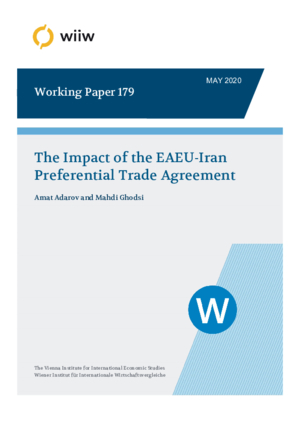The Impact of the EAEU-Iran Preferential Trade Agreement
wiiw Working Paper No. 179, May 2020
20 pages including 8 Tables and 4 Figures
The preferential trade agreement between the Eurasian Economic Union (EAEU) and Iran on mutual trade entered into force in October 2019. In this report we estimate its expected impact at aggregate and sectoral levels using the gravity model of trade based on the global sample of bilateral trade flows at the HS 6-digit level. The analysis suggests that the implementation of the agreement will boost mutual trade for both trading partners, with relatively greater gains expected for the EAEU’s exports to Iran. On aggregate, the total gains in mutual trade are estimated to reach almost USD 46 million, with exports from the EAEU to Iran expected to increase by 9.7%, compared with a rise in exports from Iran to the EAEU of up to 4%. The difference in the impact will also be significant across the five EAEU countries as well as across sectors, with the major export gains expected to accrue in the chemicals and agri-food sectors, especially trade in miscellaneous fruits and vegetables, as well as in the textile, polymer production and metals sectors.
Keywords: Eurasian integration, EAEU, Iran, trade agreement, gravity model, PPML
JEL classification: F13, F14, F15, F17
Countries covered: Armenia, Belarus, Iran, Kazakhstan, Kyrgyzstan, Russia
Research Areas: International Trade, Competitiveness and FDI
